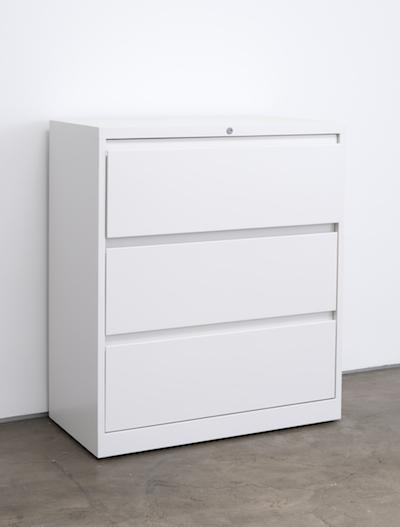“Abstract painting is all art. It’s pure in a way, simply canvas, paint and a brush.” —Artist Kaz Oshiro
Kaz Oshiro was born in Okinawa, Japan, in 1967. Growing up in the 1970s, Oshiro recalls an early interest in contemporary art after he encountered a reproduction of a photorealist painting by Robert Estes. The memory stuck with him as he was left to ponder whether or not the work was in fact a painting or a photograph.
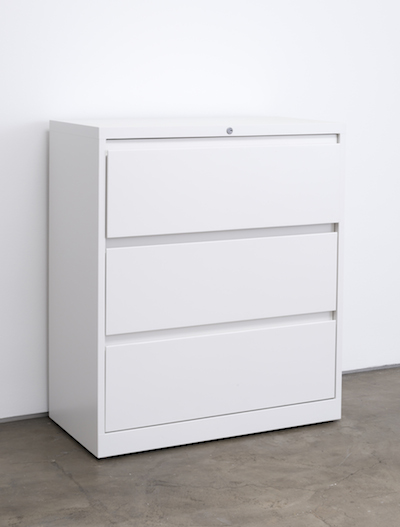 Kaz Oshiro, Lateral File Cabinet (White #1), 2013, courtesy Honor Fraser Gallery, photo Joshua White/JWPictures.com
Kaz Oshiro, Lateral File Cabinet (White #1), 2013, courtesy Honor Fraser Gallery, photo Joshua White/JWPictures.com
With this early encounter, perhaps the seeds for Oshiro’s complex practice were planted. Early in his career, Oshiro became known as a master of deception. He recreated ordinary household objects such as kitchen cabinets, microwaves, mini fridges, guitar amplifiers, and stereo speakers. What first appears to be a three dimensional object reveals itself, upon closer looking, to be a painting on canvas.
 Kaz Oshiro, Marshal Speaker Cabinet (pair), horizontal, 2013, courtesy Galerie Perrotin, Hong Kong
Kaz Oshiro, Marshal Speaker Cabinet (pair), horizontal, 2013, courtesy Galerie Perrotin, Hong Kong
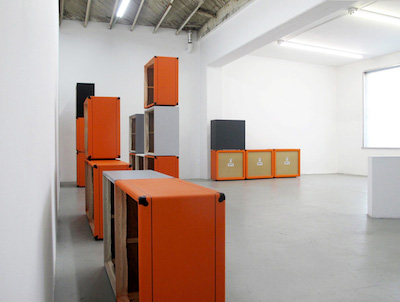 Kaz Oshiro, Speaker Cabinets and Gray Scale Boxes, courtesy Honor Fraser Gallery, photo by Steven Hull
Kaz Oshiro, Speaker Cabinets and Gray Scale Boxes, courtesy Honor Fraser Gallery, photo by Steven Hull
Complete with markings resembling ordinary wear and tear endured by objects that figure into everyday life, Oshiro’s works are made using a realist technique, which is so convincing that the paintings can be easy to miss as they blend into the environment. Assembled from stretched canvas, Oshiro’s paintings are complete with painted fixtures, which aid in the deception. The unraveling of deception only happens upon inspection behind the façade and through openings in the back of the work.
Influenced by Abstract Expressionism, Minimalism, Pop Art, and 17th-century still-life canvases, Oshiro uses painting to explore spatiality. His practice is conceptually driven, and the resulting work appears to be straightforward and minimal. The complexity of his practice is riveting, as he pushes the confines of painting by straddling the principles of both abstraction and representation. His desire to make discreet paintings is a way to intersect the principles of conceptualism, abstraction, and representation.
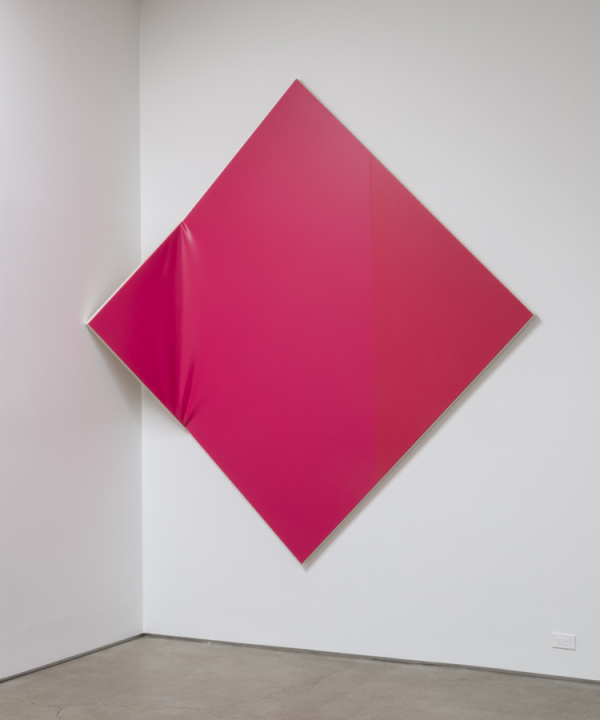 Kaz Oshiro, Untitled Still Life, 2013, courtesy Honor Fraser Gallery, photo Joshua White/JWPictures.com
Kaz Oshiro, Untitled Still Life, 2013, courtesy Honor Fraser Gallery, photo Joshua White/JWPictures.com
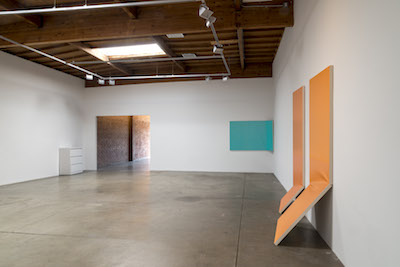 Kaz Oshiro at Honor Fraser, courtesy Honor Fraser Gallery, photo Joshua White/JWPictures.com
Kaz Oshiro at Honor Fraser, courtesy Honor Fraser Gallery, photo Joshua White/JWPictures.com
Oshiro’s latest body of work represents a formal shift from the representational to the more abstract. Moving away from the illusionary tricks employed by trompe l’oeil techniques (seen in his earlier works), the recent minimalist canvases fold the corners of the walls or collapse onto the floor. Here Oshiro plays with the spatial politics of painting, extending the conceptual practice, challenging the conventional two-dimensional picture plane and further objectifying its physical components. These works are what Oshiro describes as “still life of a broken painting.”
I spoke with Oshiro in preparation for the opening of his exhibition Kaz Oshiro: Chasing Ghosts, which takes place this Friday, January 24, at the gallery at Charles White Elementary School.
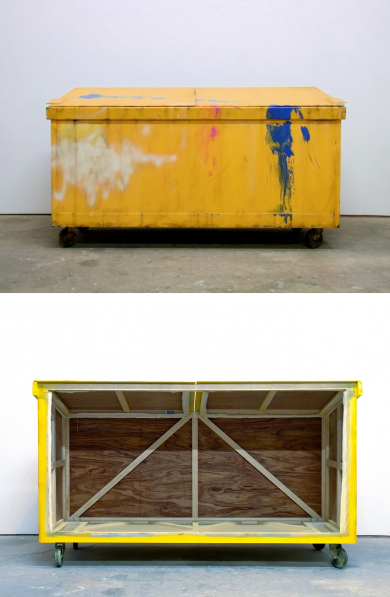 Kaz Oshiro, Dumpster (Yellow with Blue Swoosh), 2010, gift of Steven Hull and Tami Demaree, Yasmine Benyamini, and Samuel Kashani
Kaz Oshiro, Dumpster (Yellow with Blue Swoosh), 2010, gift of Steven Hull and Tami Demaree, Yasmine Benyamini, and Samuel Kashani
Nancy Meyer: Can you discuss the title of the exhibition Chasing Ghosts? Where did the idea come from?
Kaz Oshiro: My motivation to continue my art practice originates from the sense of defeat that I experienced by looking at works made by the great Abstract Expressionist painters such as de Kooning, Rothko, and other great artists in the past. The title Chasing Ghosts represents both my agony and joy of continuing my practice chasing and challenging those phantoms. I wanted to share this idea and also find the process of making art with the students in this exhibition.
NM: You’ve included some influential painters in the exhibition. Are there others not represented in the show that have had a major impact on your practice?
KO: Too many artists to list, but just to name a few, Willem de Kooning, Mark Rothko, Ed Ruscha, and John Cage have been great inspirations.
NM: Can you talk about the process of choosing the works in the exhibition and how they work in conversation with your new body of work?
KO: For this exhibition, I needed to choose work that can be made by working with students. The Dumpster is the work that projects my view on both Minimalism and Abstract Expressionism. That sounds a bit academic; on the contrary that’s an accessible object for many people. I liked the idea of painting a Dumpster with students since there is no right or wrong way to paint a Dumpster. If my Dumpsters represent my idea of painting about object, my broken canvases, Untitled Still Life represent my take on sculpture about painting. The directions seem to be completely opposite, but in fact the fundamental ideas are the same. The both are still life paintings/objects or abstract paintings/objects.
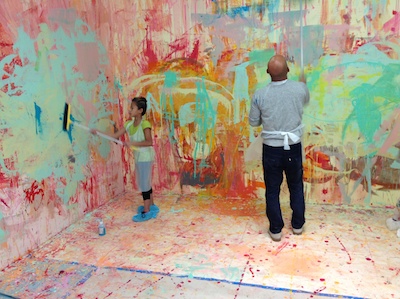 Artist Kaz Oshiro works with a student on a collaborative painting project.
Artist Kaz Oshiro works with a student on a collaborative painting project.
NM: Your work straddles the principles between abstraction and representation. What do you think about how painting is defined in this way? Do you think it’s still relevant to distinguish the two?
KO: I try not to separate abstraction and representation because I think it’s just matter of how we look at it through either macro- or micro-perspective. Probably, the reality only exists in our heads.
NM: This is the first time you have worked collaboratively and with children. Can you elaborate on your experience working with them?
KO: To be honest, I was confused when I was offered to participate in this project with students, because I haven’t had any experience working not only with students but other people much. I usually work alone in my studio without seeing anyone around me, but it turned out to be a very good learning experience. On reflection, I would make some improvements in organizing workshops and exhibitions plan if I have another chance . . . that’s probably a good sign. I enjoyed watching the students having a fun painting with nontraditional tools to create a big mess.



